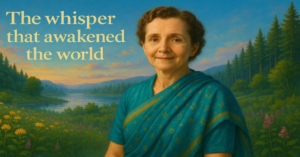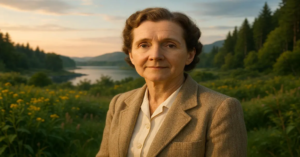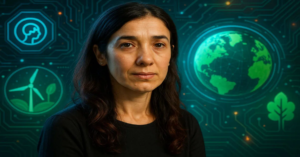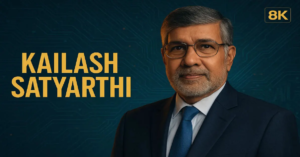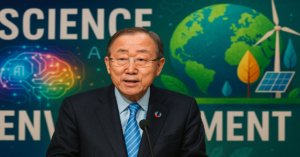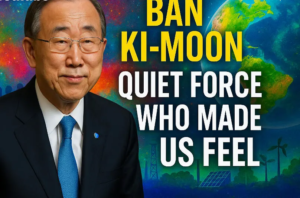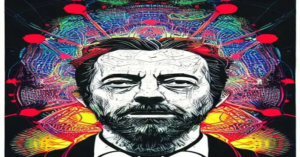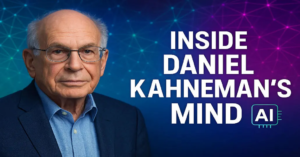Jane Goodall in Gombe: A Vision of Hope
The Girl Who Listened to Earthworms
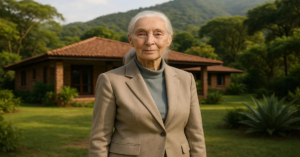
Rain drummed a secret rhythm on the tin roof of the henhouse. Four-year-old Jane Goodall pressed her palms into the cool, damp earth, holding her breath as straw pricked her knees. The speckled hen clucked nervously. “Just one more minute,” Jane willed silently, her small body coiled in anticipation. When the egg finally dropped into the nest, she scrambled home, cradling the warm treasure. Mud streaked her dress like war paint. Straw clung to her curls. Her mother Vanne didn’t scold. She knelt, brushing dirt from Jane’s cheek. “How did you wait so long, my darling?” she whispered.
That moment became Jane’s soul-deep compass:
- Patience: Learning stillness as the wary hen returned.
- Curiosity: Sketching earthworms in rain-soaked notebooks as bombs fell on wartime Bournemouth.
- Empathy: Vanne’s quiet nod when Jane declared, “Animals have feelings, Mummy. Like us.”
Africa Called. Jane Goodall Answered with a Typewriter and a Dream.
At 23, Jane stacked plates at a seaside hotel, saving shillings in a jam jar labeled “AFRICA.” When friends asked, “Why risk lions and malaria alone?” she’d grin: “Because Tarzan married the wrong Jane!” On the creaking boat to Kenya, she typed letters for Louis Leakey—a fossil hunter with eyes like flint. He noticed her during tea breaks, tracking vervet monkeys through the acacia trees. “Their fingers… like tiny humans,” she murmured, lost in wonder. Leakey saw what no university could teach: a heart that beat in sync with wild things.
Gombe: Where the Forest Whispered Its Secrets
July 1960. Tanzania’s Lake Tanganyika.
Heat hung thick as wet wool. Mosquitoes whined in Jane’s ears as she climbed razor-edged ravines. For months, chimps melted into green shadows at her approach. Blisters split her boots. Loneliness ached like hunger. Then—David Greybeard.
An elder chimp with a frosted muzzle and eyes that held ancient knowing. He let her sit ten paces away. Then five. One misty morning, he did the impossible:
- Snapped a twig from a vine.
- Peeled the leaves with surgeon’s precision.
- Dipped it into a termite mound, fishing out wriggling insects.
“They’re making tools,” Jane breathed, ink smearing her trembling notes. When she wired Leakey, laboratories erupted. “Now we must redefine ‘man,’” he wrote back, shattering human exceptionalism forever.
But Jane saw deeper truths:
- Flo, her chapped hands cradling infant Flint like precious china.
- Fifi, stealing her brother’s fruit with a mischievous hoot.
- Grief when Flint refused to leave Flo’s corpse—curled beside her for weeks, hollow-eyed, until he too stopped breathing.
“They’re persons,” Jane insisted. Cambridge dons scoffed into their sherry: “Anthropomorphic drivel!” She met their stares, voice steel: “Would you deny grief to a dog at its master’s grave?”
Jane Goodall the Forest Screamed Silence
Years later, Jane clutched a plane’s cold window. Below—bald hills gashed with red clay. Trees ripped out like rotten teeth. Chimps huddled in emerald fragments. “Like watching my children buried alive,” she’d say later, tears raw in her throat. The scientist laid down her binoculars. The warrior rose.
Jane Goodall Weapon? Relentless Hope.
1. Jane Goodall Healing Hands, Land
In Ugandan villages, Jane sat on dirt floors, sipping bitter banana beer. She listened:
- “We cut trees because the soil bleeds dust,” farmers confessed.
- “No clean water. Our babies die,” mothers whispered.
Her team answered with hands, not handouts:
- Beehives → Golden honey for market → Logging axes stilled.
- Village nurseries → 3 million trees clawing back the hills → Chimps reclaiming stolen corridors.
“Save the forests?” Jane mused. “First, you must save the people.”
2. The Orphans Who Stole Jane Goodall Heart
At Tchimpounga Sanctuary, infant chimps arrived wrapped in rags—eyes vacant, fingers clutching air where mothers should be. Jane’s team:
- Rocked them through nightmares, humming lullabies.
- Guided their hands around mangoes, sticky juice on fur.
- Built forest-islands where orphans forged new families.
A caretaker wiped sweat from her brow: “Rescue isn’t pity. It’s saying, ‘Your life matters.’”
3. The Kids Who Refused to Wait
1991. Tanzanian teens stormed Jane’s tent, plastic bags crunching underfoot: “Our beach chokes! What can we do?”
That spark became Roots & Shoots—now 150,000 fists of change worldwide:
- A Tokyo boy’s crayon petition → Supermarkets banned plastic.
- Kenyan girls → Planted 10,000 mangroves, roots knitting eroding shores.
“Children don’t see walls,” Jane laughed. “They see ladders.”
Jane Goodall Behind the Legend: Love, Loss, and Unbroken Spirit
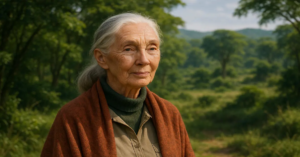
- Love: Her husband Derek died of cancer after five radiant years. She grieved in Gombe’s embrace. “The chimps knew,” she recalled. “Fifi groomed my hair so gently—like I was her own.”
- Magic: At 91, she still opens talks with a guttural “Wooooah!”—Flo’s greeting call. Audiences gasp. “That means ‘I see your soul!’”
- Faith: When climate despair loomed, she’d point to a sidewalk crack: “See? A dandelion shattering concrete. Be that defiant yellow.”
Why Her Story Still Grows
“You sip morning coffee. Was it harvested by enslaved hands? Or fair-trade farmers sending kids to school? That choice echoes. Every. Single. Dawn.”
Jane still travels 300 days a year. Her uniform tells her story:
- Blazer pocket: Jubilee, her threadbare childhood chimp.
- Shoulder bag: Crayon-smeared letters from Roots & Shoots kids.
- Voice: Feather-soft, yet it shakes auditoriums.
Her living legacy?
| Not just 340,000 saved forest acres breathing again. |
| Not just 200 rescued chimps learning to trust. |
| It’s the spark she ignites: |
| The ex-poacher tending organic tea fields, whispering “Jane believed in me.” |
| You, reading this, pausing your scroll—“What’s my dandelion move today?” |
Last Light:
At dinner once, I dared ask: “What’s the bravest thing you’ve done?”
She set down her tea. “Believing that one woman—a secretary, a dreamer, a nobody—could rewrite humanity’s place in nature’s story. And then…” Her eyes crinkled. “Doing it anyway.“
